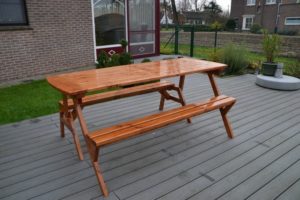Last Updated on August 6, 2024 by teamobn

If you’re looking for a potting bench for your garden but don’t want to spend a lot of money, you can easily build your own using an old wood door. This project is relatively simple and can be completed in just a few hours. Plus, by using an old door, you’ll be giving it a new life and saving it from ending up in a landfill.
This is a great way to get a custom-built potting bench that’s better suited to your needs than a store-bought model. Plus, it’s a fun project that you can do yourself!

You can have it in any size that you want. And the hooks for your garden tools, the number of shelves for your pots and all other features that you want to have in your potting bench are all up to you. (Just don’t forget to include a closed storage like a drawer for items that you need to protect from bad weather 😉 )
This idea can also be a no-cost project if you happen to already have a broken wooden door. And instead of buying new parts like hooks and table legs, you can use other old, broken odds and ends that might be simply gathering dust in your storage. Old silverware or keys can serve as hooks and scrap timber can be used as legs or shelving.
With this upcycling project you not only have an inexpensive potting bench, but you also have a unique addition to your garden!
Contents
Creating a Potting Bench
Click on any image to start the lightbox display. Use your Esc key to close the lightbox. ?
Materials
- Old Wooden Door
- Chicken Wire
- Timber Planks
- Old Silverware
- Iron Bar
- Paint
- Wood Screws
- Brackets
- Hook Screws
- Broken Table
Tools
- Cordless Drill
- Paintbrush
- Saw
Steps
Start by cleaning up your broken table. You can sand them down and remove the legs, leaving two legs on the table. You can then use a saw to cut the table in half, creating two smaller surfaces. You’ll only be needing one part of the table.
Attach one of the halves of the table to your old wooden door using screws or nails. This will create a sturdy surface to work on. You may need to sand or plane the door first to create a smooth surface.
When you have attached the table to the old wooden door, you may want to add more shelving by attaching timber planks to the door. You can add brackets to help support the shelving and make it more sturdy. This is a great way to add more storage and functionality to your potting bench!
You can also screw in hook screws to the old wooden doors for your potting tools. This includes your garden trowel, gardening fork, hedge shears, gardening gloves, pruning shears, and any other gardening tools you may have. Not only will this give you easy access to your potting tools, but it will also help to keep your gardening area more organized.
Now that you have all the parts assembled, you can paint the potting bench. You’ll want to choose a paint that will withstand the elements and won’t fade too quickly. A good quality exterior paint should do the trick. Once you’ve decided on the paint, apply a primer to the bench. This will help the paint to adhere to the surface and provide a more even finish.
After the primer is dry, you can start painting the bench. Be sure to use a brush or roller designed for use with exterior paints. Apply the paint in even strokes, going with the grain of the wood. You may need to apply several coats of paint to get the desired coverage. Let the paint dry completely between coats.

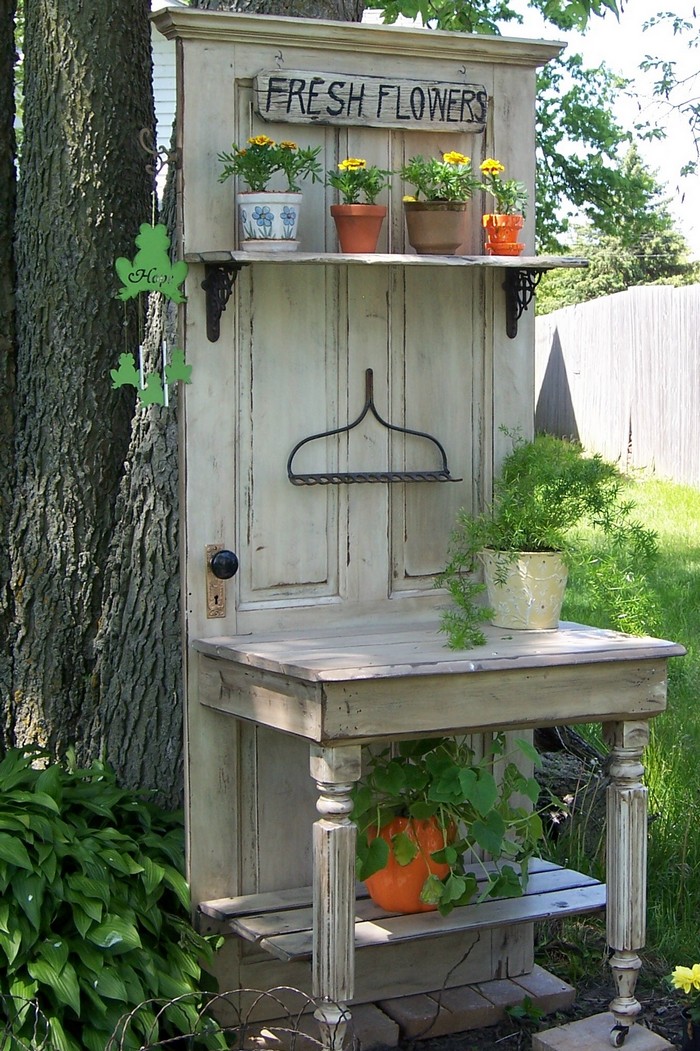
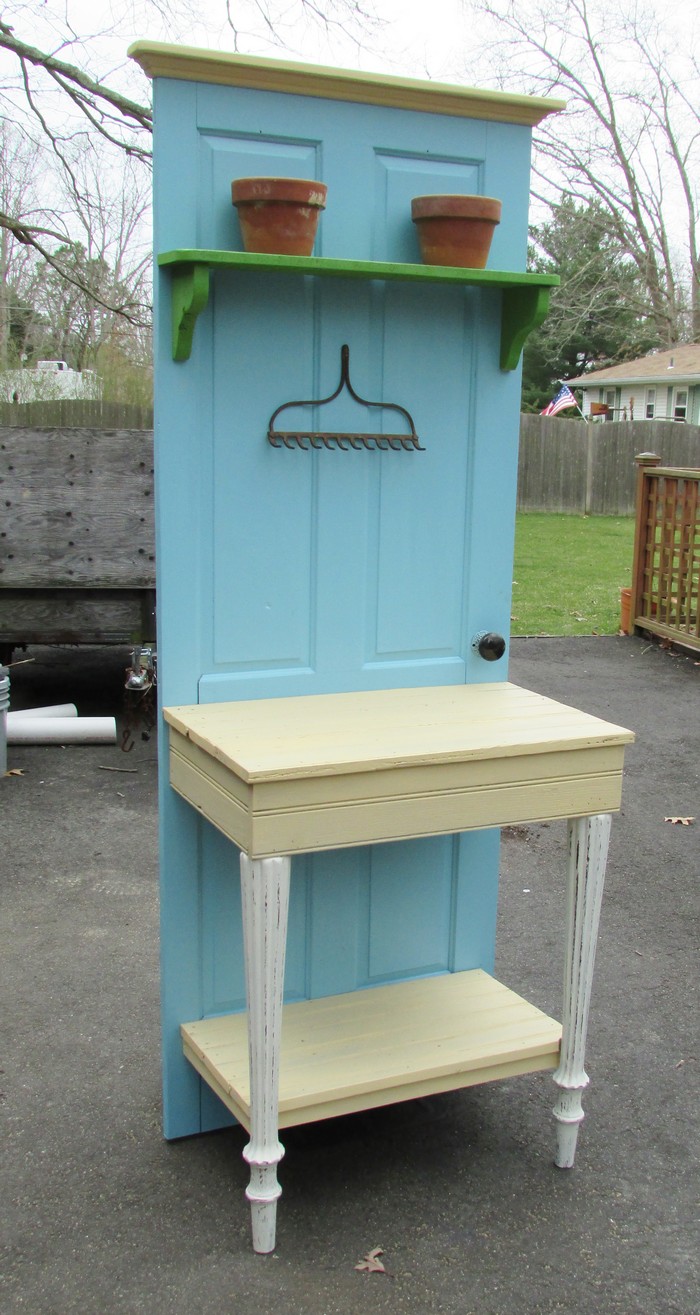
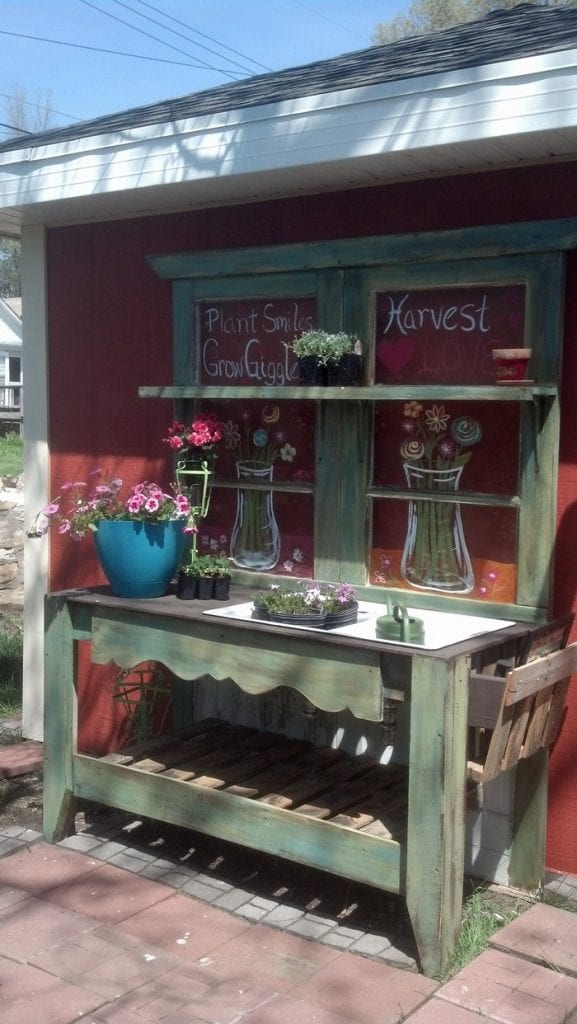
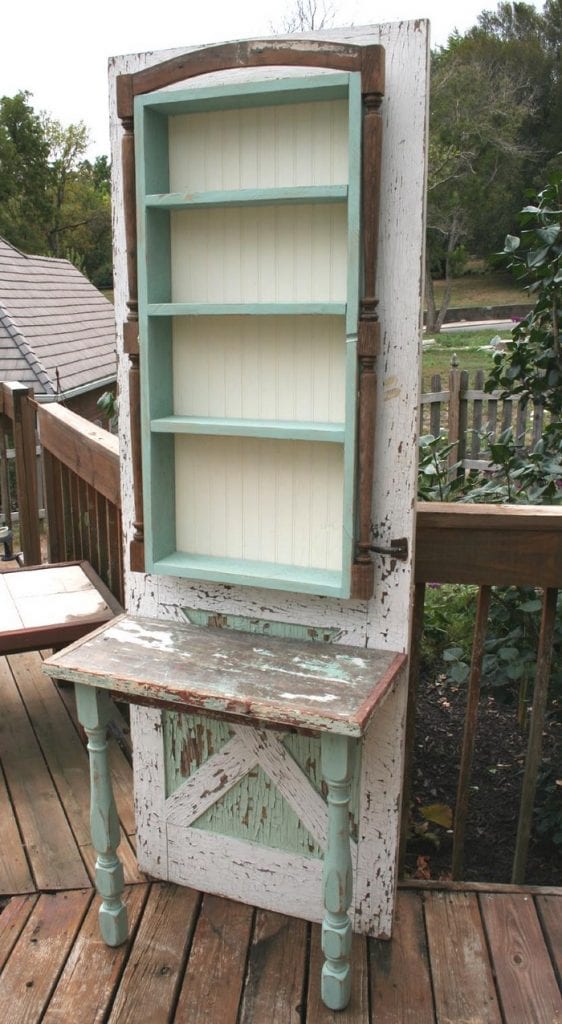
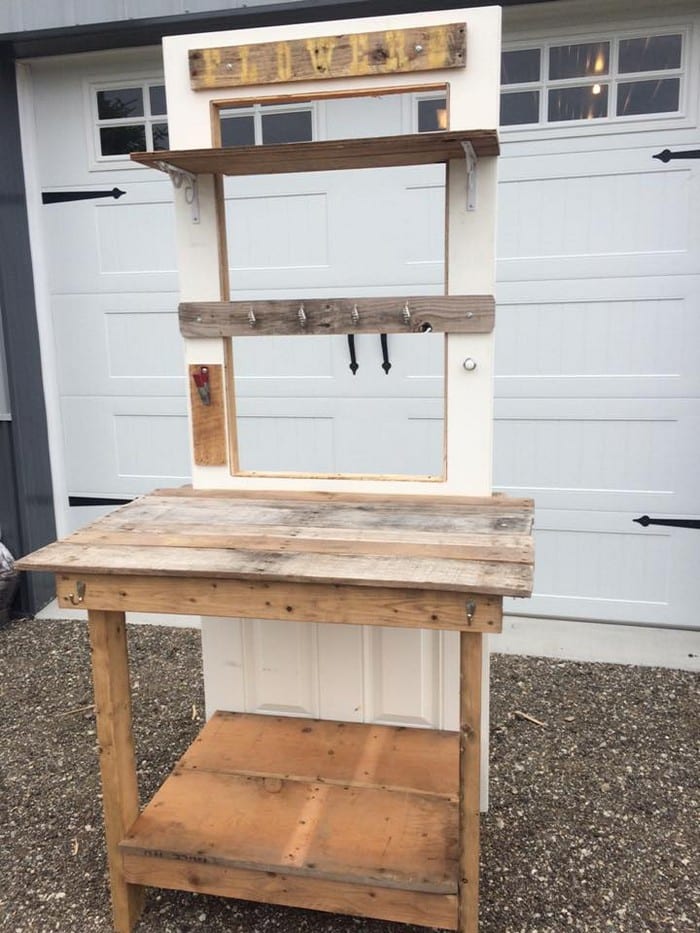

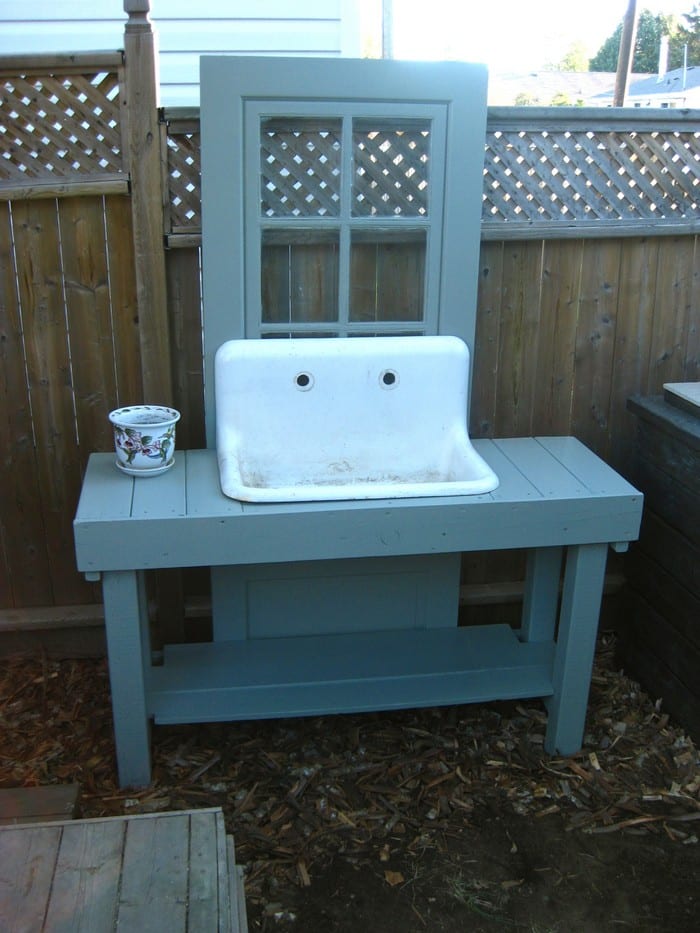
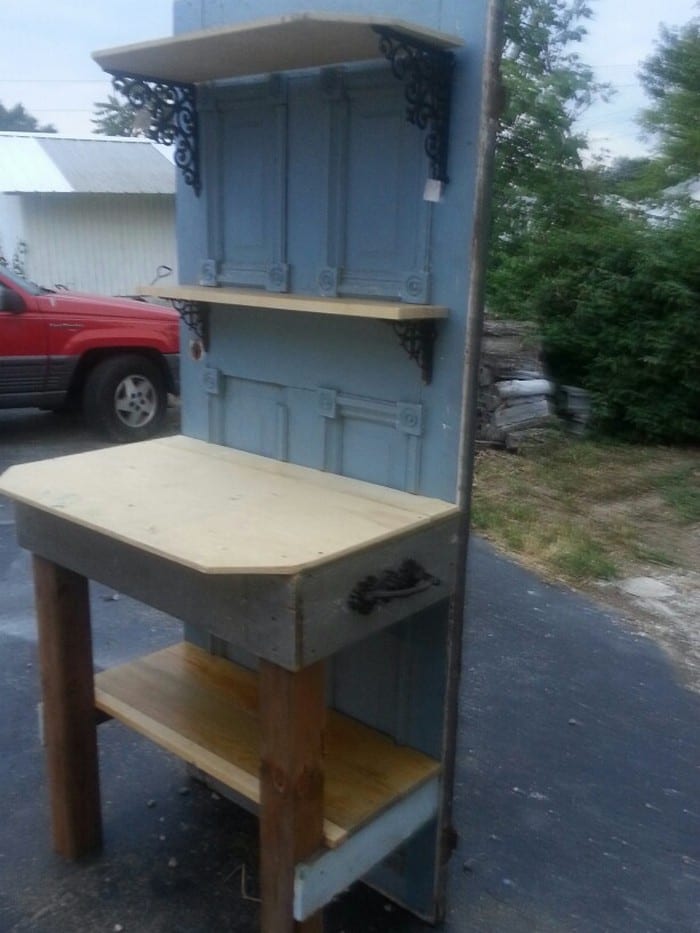
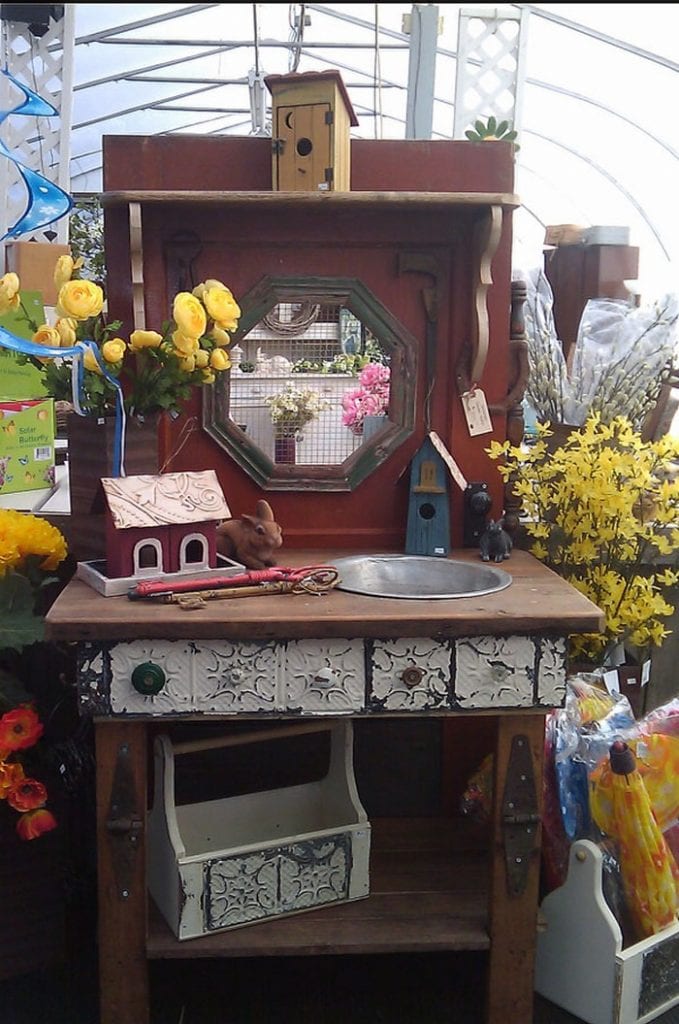
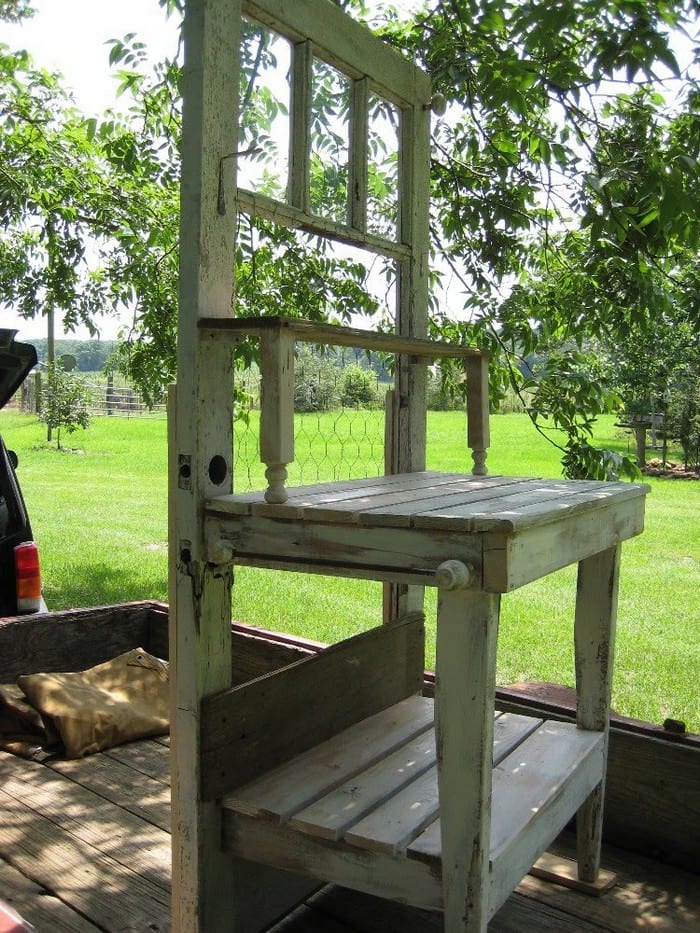
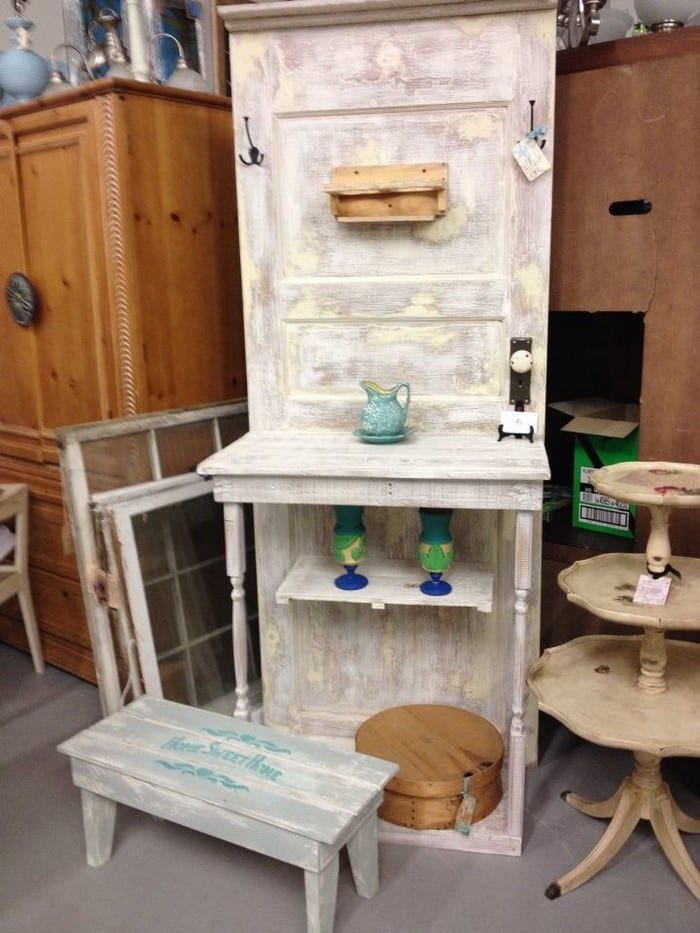
You can get step-by-step instructions from Cottage and Cabin Interiors and Collections over here…
Design Variations for Different Garden Styles
Designing a potting bench that complements your garden’s style not only elevates the aesthetic of your outdoor space but also enhances your gardening experience. By carefully selecting materials, colors, and accessories, your potting bench can become a central feature of your garden that is both functional and stylish.
Here are some design variations tailored to different garden styles:
Rustic Garden Charm
A rustic-style potting bench is ideal for those who appreciate a natural, country-inspired garden. Use reclaimed wood or an aged wood door to maintain an authentic, worn look that blends seamlessly with the rustic theme.
Enhance the bench with wrought iron hooks and antique knobs to add character. Staining rather than painting the wood can also preserve the natural grain, enhancing its rustic appeal. For a personal touch, add a vintage watering can or old terracotta pots to the shelves, providing both decoration and functionality.
Modern Minimalist
A modern garden calls for a sleek, streamlined potting bench design. Opt for a clean, simple structure using materials like stainless steel or painted MDF to create a more contemporary look. The color scheme should be monochrome or include shades of gray and white, keeping the design minimalistic and neat. Incorporate geometric shapes and straight lines in the bench design. For functionality, integrate hidden storage compartments and ensure the surface is wide and uncluttered, ideal for modern gardening accessories.
Cottage Garden Delight
Cottage gardens, known for their whimsical and colorful nature, are perfectly complemented by a potting bench that reflects the same charm. Paint the bench in bright colors like blue, green, or yellow to echo the vibrancy of a cottage garden.
Adding details like scalloped edging or floral motifs can enhance its quaintness. Use hooks for hanging garden tools and shelves for displaying an array of potted plants. Incorporating a chalkboard sign where you can write daily gardening tasks or inspirational quotes can also add a playful and practical element to the bench.
Coastal Retreat
For gardens by the sea or for those who love a maritime theme, a coastal-style potting bench can be very appealing. Paint the bench in shades of blue, turquoise, or sandy beige to mirror the beachscape. Use materials resistant to humidity and salt, like treated wood or corrosion-resistant metals.
Decorative touches like ropes, starfish, or shells glued around the edges of the bench or used as drawer handles can enhance the oceanic feel. Opt for a weathered finish to mimic the effect of sea and sand erosion, giving your potting bench an authentic coastal look.
Zen-Inspired Sanctuary
In a garden designed for tranquility and reflection, a Zen-inspired potting bench should emphasize simplicity and harmony with nature. Use bamboo or dark-stained wood to construct the bench, keeping the lines simple and the surface uncluttered.
A minimalist design with hidden storage for tools and supplies maintains the serene and orderly atmosphere. Incorporate elements like a small bamboo fountain or a space for a bonsai collection on the bench to enhance the sense of calm.
By adapting your potting bench to fit the theme of your garden, you not only create a functional workspace but also a piece of garden furniture that enhances the overall beauty of your outdoor area. Whether you choose a rustic, modern, cottage, coastal, or Zen style, your potting bench can be a statement piece that reflects your personal gardening style and passion.
Landscaping Integration
Integrating a potting bench into your landscape design not only enhances functionality but also elevates the aesthetic appeal of your outdoor space. Whether you’re an avid gardener or a novice, positioning your potting bench strategically within your garden can maximize its utility while complementing the surrounding environment.
Here’s how to seamlessly integrate your potting bench into different landscaping setups:
Central Feature
Positioning your potting bench as a central feature in your garden can make it a focal point of your outdoor space. This approach works well in larger gardens where the bench can serve as an anchor for the design.
Surround your potting bench with lush plantings or a curved pathway to draw attention to it. Consider adding an overhead arbor or trellis adorned with climbing vines to provide both shade and a dramatic backdrop. This setup not only highlights your potting bench but also makes it a charming spot for potting plants and a center for gardening activity.
Discreet Utility
For smaller gardens or when you prefer a more understated look, tuck your potting bench into a discreet corner of your yard. Choose a location near a boundary wall or hidden behind tall bushes to maintain an uncluttered view of the rest of the garden.
This placement makes the potting bench easily accessible yet out of the main sight lines, allowing you to enjoy an unobstructed view of your garden from your house or patio. It’s ideal for keeping gardening tools handy without them being the focus of your garden.
Multi-Functional Zone
Create a multi-functional zone in your garden by integrating your potting bench with other outdoor elements like a greenhouse, storage shed, or composting area. This not only centralizes your gardening activities but also makes maintenance tasks more efficient.
Position the potting bench so it acts as a transition point between the cultivation area and the relaxation areas of your garden. By doing this, you maintain an organized flow in your outdoor space, making it easier to move from one activity to another while keeping all necessary tools and supplies at arm’s reach.
Visual Continuity
Ensure visual continuity by matching the style and materials of your potting bench with other garden structures such as fences, garden beds, and decks. If your garden features a lot of woodwork, choose a wooden potting bench that complements this theme.
Alternatively, for a more modern garden, consider a potting bench with clean lines and metallic finishes. Coordinating the materials and colors helps to unify the space and creates a cohesive look that blends the bench smoothly with the surrounding landscape.
Integrating your potting bench into your garden’s landscape design not only enhances its functionality but also its visual appeal. Whether you choose to make it a standout feature or a subtle addition, the right placement and consideration of surrounding elements will ensure your potting bench is both a practical and beautiful part of your garden.
Conclusion
Crafting a potting bench tailored to your personal style and garden needs transforms gardening into a more enjoyable and efficient task. With the right materials and thoughtful design, your bench becomes a central piece in your landscape, blending functionality with aesthetic appeal. This project not only saves money but also enhances your gardening experience, making each moment in the garden even more rewarding.






